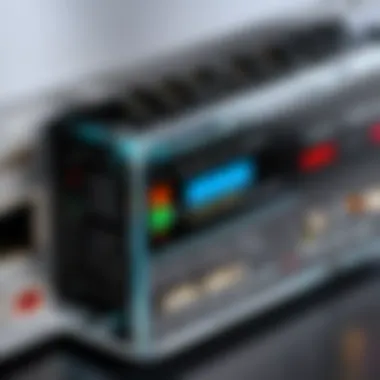In-Depth Guide to RJ45 Pinout: Structure and Uses


Intro
Understanding the intricate workings of network connections, one often stumbles upon the term RJ45 pinout. It might sound technical, but at its core, it deals with the physical arrangement of wires within an Ethernet plug. As our reliance on high-speed internet and seamless connectivity grows, knowing how these configurations operate becomes invaluable—not just for the professionals but also for anyone keen on understanding the backbone of modern communication.
In technology-driven environments, clarity in wiring standards is paramount. Miswired connections can lead to a host of problems including data loss, latency issues, and even network failures. By diving into the world of RJ45 pinouts, one can not only appreciate how various devices communicate across vast networks but also gain insights that can aid in troubleshooting and optimizing network performance.
This exploration will assist novices in grasping foundational concepts while providing seasoned IT professionals with nuanced details that underscore the importance of pinouts in ensuring smooth data transmission.
As we unravel this topic further, it’s essential to keep in mind the practical implications this knowledge holds. Whether it’s setting up a small office network or troubleshooting a larger organizational infrastructure, understanding RJ45 pinout standards and configurations is an essential skill.*
Understanding RJ45 Connectors
In the realm of networking, RJ45 connectors play a vital role as the gateway connecting devices for effective communication. Recognizing the nuances of these connectors can significantly enhance one’s grasp of networking dynamics. The importance of RJ45 connectors cannot be overstated—they are essential for establishing robust data transmission pathways, utilizing copper cabling. As businesses evolve digitally, understanding these connectors equips both novices and seasoned professionals with the necessary tools to troubleshoot, configure, and enhance their network setups.
What is an RJ45 Connector?
An RJ45 connector is commonly associated with Ethernet connections. It consists of eight metal pins housed within a plastic shell, designed to accommodate a standard Ethernet cable. Primarily used in local area networks (LANs), these connectors ensure effective data transfer through structured cabling. The connectivity provided by RJ45 enables various devices such as computers, routers, and switches to communicate seamlessly, fostering a reliable network.
The term "RJ" stands for "Registered Jack," and the number 45 denotes the specific type of connector. Originally crafted for telephone services, its role has evolved significantly, becoming a staple in the networking world.
Physical Characteristics of RJ45
Examining the physical structure of RJ45 connectors reveals several noteworthy attributes. The construction typically features:
- Plastic casing: Provides insulation and durability.
- Metal pins: These are often gold-plated to eliminate oxidation, ensuring a sustained and reliable electrical connection.
- Latch mechanism: This serves to secure the connector in place, preventing accidental disconnections.
Usually, RJ45 connectors are easily distinguishable by their larger size compared to other modular connectors, ensuring that users can identify them swiftly. The arrangement of the pins, specifically the wiring standards like T568A and T568B, is fundamental to ensuring proper communication across devices.
Applications of RJ45 Connectors
RJ45 connectors serve a multitude of functions in various applications. Their primary use is in establishing Ethernet connections for:
- Local Area Networks (LANs): RJ45 connectors are the backbone for devices connected within a close proximity, such as telecommunication equipment in an office.
- Internet connections: Used in modems and routers, these connectors facilitate seamless internet access for multiple devices.
- Data centers: Essential for server connections, they support high-speed data transfer amidst numerous networked systems.
- Home networking: The connectors are commonly employed in household Ethernet setups, facilitating wired connections to enhance stability and bandwidth for tasks like streaming or gaming.
Given their versatility, RJ45 connectors are integral in our increasingly digital world, laying the foundation for reliable connectivity and communication across various platforms and devices.
The RJ45 Pinout Configuration
Understanding the RJ45 pinout configuration is crucial in networking environments, as it serves as the backbone for data transmission in local area networks. It ensures that signals are sent and received accurately, which is essential for maintaining consistent communication and preventing misconfigurations that could lead to issues such as data loss or degraded performance.
Overview of Pinout Structures
Pinout structures refer to the arrangement of the wires within an RJ45 connector. These arrangements dictate how information is transmitted over the cable. Knowing these structures helps professionals determine the appropriate wiring configuration for the intended application. The integrity of a network largely depends on the correct pinout setup. Each configuration has specific use cases, and missteps can result in the connectivity woes that everyone dreads, like flaky connections or complete failures to communicate.
Standard Pinout Types


When discussing RJ45 connectors, it's important to know that there are three main pinout classifications: Straight Through Wiring, Crossover Wiring, and Rolled Wiring. Each of these types plays a distinct role in setting up a network, and their advantages and scenarios of use can vary widely.
Straight Through Wiring
Straight Through Wiring is the most common configuration when connecting devices of different types, such as a computer to a switch or hub. The key aspect of this wiring type is its straightforward approach: it maintains the same pin order at both ends of the cable.
This consistent structure allows for the reliable transmission of data signals and reduces the chances of errors in communication. Its simplicity makes it a widely embraced choice. Most home and small business network setups employ this wiring method, given that it's often plug-and-play with minimal setup required.
However, its limitations are evident when it comes to direct connections between similar devices, such as computer-to-computer links, where alternative configurations might be more appropriate. Despite that, the ease of use and reliability of Straight Through Wiring cannot be overstated; it's often the go-to choice in various networking scenarios.
Crossover Wiring
Crossover Wiring can be critical when connecting like devices directly—for instance, connecting two computers or two switches. This wiring type swaps the transmitting and receiving pairs; in essence, it gets things crossed, which allows the devices to communicate.
The unique characteristic here is its adaptive capability in situations where a standard wiring configuration would fail to establish a connection. While not as commonly utilized as Straight Through Wiring, Crossover Wiring can save the day in a pinch, allowing for peer-to-peer setups without additional equipment such as a switch. However, it’s worth noting that many modern devices auto-sense the type of connection and can adapt accordingly, diminishing the need for crossover cables in many scenarios.
Rolled Wiring
Lastly, Rolled Wiring serves a very specific function, frequently found in connecting certain terminal equipment to network devices. This method involves reversing both the pin order and the functionality of the wires. In practice, this means that the pins that transmit on one end will receive on the other end and vice versa.
A key characteristic of Rolled Wiring is its specialized nature. Often used in applications like console cables, its primary benefit is enabling communication with devices that require a distinct pinout configuration, such as routers or switches during setup or troubleshooting.
Despite its limited scope, Rolled Wiring excels in niche environments, particularly for technicians needing to access the console of network equipment. However, it's not a common choice for everyday networking tasks.
"A thorough understanding of the RJ45 connector and the appropriate wiring type is critical in avoiding many common networking headaches."
Detailed Analysis of Wiring Standards
Understanding wiring standards is more than just a technical necessity; it's a pivotal factor in maintaining robust communication systems. In networking, an RJ45 connector's functionality hinges largely on how its pins are wired, and the choices made in wiring schemes can have lasting effects on network performance. Two of the most widely recognized standards are T568A and T568B. All of this underscores the importance of conscientious wiring and its implications on efficiency and reliability.
T568A vs. T568B
Comparison of Wiring Schemes
When we dive into the comparison of T568A and T568B, one notable point is their pin configuration. Both standards dictate how the individual wires within the Ethernet cable should be organized, but they slightly differ in pin assignment. T568A has pins 1, 2, 3, and 6 as transmitting and receiving pairs, whereas T568B interchanges pairs 2 and 3. This seemingly small distinction can become crucial depending on existing infrastructure or specific requirements of a project.
Choosing one over the other may reflect on the compatibility with certain hardware or legacy systems. Customers often opt for T568B more frequently than T568A due to historical preferences in the United States. Network managers sometimes see better performance due to the widespread adoption of this standard, making it the de facto choice for many installations.
The unique feature for T568A, on the other hand, is its designation for structured cabling installations. This is especially beneficial for government installations or any situation where a standardization across various platforms is essential, enabling easier troubleshooting and less ambiguity.
Applications in Networking
T568A and T568B serve not just as technical standards but also reflect the specific needs of different networking situations. In environments where multiple existing installations prevail, the choice can greatly affect compatibility. For instance, T568B is often recommended for interfacing with older telephone systems or coaxial connections— relics from yesteryears— that persist in numerous older buildings.
Conversely, T568A is a choice often seen in new constructions or implementations aiming for forward-looking integration with VoIP telephony systems. Its structure promotes better transmission efficiency due to its pairing, which allows for reduced crosstalk and enhanced data quality.


Importance of Consistency
Consistency can't be overstated when it comes to networking. Mixing T568A and T568B standards within the same network can lead to connectivity issues, degrading performance or outright failures. A thorough understanding of these standards helps not just in ensuring compliance but also in catering to manufacturers and infrastructural frameworks, thereby securing robust connectivity.
Using a single wiring scheme throughout an installation can streamline maintenance and simplify troubleshooting processes. It aids in preventing misconfigurations, which can provoke unexpected issues down the line. Maintaining this kind of structural integrity is paramount, especially in environments where downtime can be costly.
Ensuring that wiring standards are consistently followed is crucial for achieving optimal network performance and simplicity in management.
In summary, the detailed analysis of wiring standards such as T568A and T568B gives valuable insight into the workings of network cables and helps IT professionals make informed decisions for their infrastructure.
Common Issues Related to RJ45 Pinout
Understanding common issues tied to the RJ45 pinout is essential for anyone dabbling in networking, be it a newbie trying to set up a home network or an IT professional managing enterprise systems. These problems can severely affect connectivity, causing everything from intermittent drops to complete outages. Knowing the intricacies helps not only in swift problem solving but also in preventing these issues from arising in the first place.
Misconfigurations and Their Effects
Misconfiguration is often at the heart of many network issues. Whether it's a mistake in the pinout arrangement or an accidental mix-up in wiring standards like T568A and T568B, the consequences can be significant. A common error occurs when a technician connects devices using the wrong wiring configuration. For example, using a crossover cable where a straight-through is needed can lead to a dead connection. Besides connectivity loss, misconfigurations can introduce latency issues and data integrity problems.
To illustrate, if a network cable that should be wired to transmit data on pins 1 and 2 instead routes the signal through pins 3 and 6, data packets may arrive out of order or not at all. This not only frustrates users but also puts additional strain on network resources, leading to cascading failures. Thus, taking time upfront to ensure correct connections pays dividends down the line.
Troubleshooting Pinout Problems
Identifying Common Symptoms
Identifying common symptoms of RJ45 pinout problems is pivotal for effective troubleshooting. Often, the first sign of a connectivity issue is the familiar flashing red light on a network switch or a sluggish Internet connection at a workstation. If the symptoms point toward cable issues, it can save a considerable amount of time in isolating the root cause.
Understanding these symptoms involves with noting that physical connectivity, often taken for granted, can be disrupted due to a variety of factors such as wear and tear or environmental conditions. Alongside visual cues, tracking down specific error codes and logs from connected devices also serves a great purpose in identifying problems quickly. Leveraging this easy approach not only shortens diagnosis time but also enables quick resolutions, allowing tech teams to keep everything running as smooth as a well-oiled machine.
Tools for Troubleshooting
Equipping oneself with the right tools for troubleshooting is invaluable in diagnosing RJ45 pinout issues. A cable tester, for example, can quickly determine if a cable is wired correctly or if there are breaks in the lines. Not only is this tool essential, but it can also provide real-time feedback on connectivity. In addition, having a multimeter on hand can help measure voltage or current in the connection, indicating whether power issues might be contributing to the problem.
Furthermore, there are many software tools available that can assist in diagnosing network issues by performing ping tests, checking packet loss, and measuring latency. However, while these devices typically provide immediate data and diagnostics, they do have limitations and often require human intervention to interpret the results accurately. Whether through hardware or software, utilizing these tools is a crucial step toward ensuring a reliable RJ45 pinout configuration.
Best Practices for Using RJ45 Connectors
Using RJ45 connectors may seem trivial at first glance, but the truth is, the difference between a reliable connection and a frustratingly intermittent one often hinges on a few best practices. These practices ensure not just effective communication across networks but also longevity for the equipment involved. Let’s dive into how informed decisions can sidestep common pitfalls and boost performance in every project, whether it's a home setup or a corporate network.
Selecting the Right Cables
When it comes to selecting cables for your RJ45 connections, misunderstandings can lead to all sorts of headaches. Not all cables are created equal. For instance, Category 5e (Cat5e), Category 6 (Cat6), and Category 6a (Cat6a) are the go-to options, but the choice largely depends on your network's requirements. Here are some key points to consider:
- Bandwidth Needs: Determine the bandwidth requirements for your applications. Cat5e supports up to 1 Gbps, while Cat6 can handle up to 10 Gbps for short distances.
- Distance Limitations: For longer distances, Cat6a provides a better range without compromising performance.
- Environmental Factors: Be aware of environments: if cables will be exposed to moisture or electrical interference, opt for standard Ethernet cables with shielding, like shielded twisted pair (STP).
Ultimately, a good cable is the foundation for a robust network. The right choice saves both time and resources later on.


Proper Installation Techniques
Getting installation right is essential. It doesn’t matter how good the equipment is; if it’s not installed properly, you're setting yourself up for issues. Here’s what to keep in mind:
- Cable Length: Keep your cable lengths under 100 meters for optimal performance. Beyond that, signal degradation can set in fast.
- Twist Pair Maintenance: Maintain the twist of each wire pair as you strip insulation and terminate the connectors. This helps to minimize interference and maintain signal quality.
- Secure Connections: Make sure that each RJ45 connector is firmly attached. A loose connector can manifest as intermittent connectivity issues, sometimes leaving users scratching their heads without understanding what's gone wrong.
Using the right techniques not only enhances performance but also extends the lifespan of your networking setup.
Routine Maintenance and Testing
Just as you wouldn’t skip regular check-ups for your car, your network’s health deserves attention too. Regular maintenance and testing can identify problems before they escalate, which is vital for ensuring uninterrupted service. Here are practical approaches to keep things running smoothly:
- Visual Inspections: Periodically look over cables for any signs of wear and tear. Even small frays can become major issues if they're not caught in time.
- Cable Testing Tools: Use cable testers to check for continuity and signal integrity. Tools that identify faults, like open circuits or short circuits, can save you significant troubleshooting time.
- Documentation: Keep a log of equipment and testing results. Documenting your installations and test outcomes helps in tracking performance trends and making informed decisions down the line.
With consistent maintenance, not only do you sidestep a heap of potential issues, but you also ensure that your system performs at its best.
"Success hinges on details. In networking, the finer points can make a world of difference."
The Future of Networking and RJ45
In the fast-paced world of technology, the future of networking, particularly with RJ45 connections, is a topic of significant relevance. As data demands increase and newer technologies emerge, understanding the evolution of RJ45 is not just a technical curiosity; it’s a necessity for anyone in the field. This section will explore how the RJ45 pinout structure is adapting to new standards and why it remains a cornerstone in networking today.
As we stand on the cusp of a new era of connectivity, the RJ45 connector evolves to meet these changes. Its role in facilitating high-speed data transmission continues even amidst advancements like fiber optics or wireless technologies. There's a growing advantage to using RJ45, especially with new Ethernet standards pushing performance limits. It’s important to recognize how these developments can potentially bridge traditional setups with the cutting-edge solutions of tomorrow.
Evolving Standards and Technologies
The RJ45 connector has been a constant in the world of networking, but it isn't static. The evolution of networking standards has been pivotal in refining its use. With the rise of standards like IEEE 802.3bz, which increases the speed of Ethernet over twisted pair cables, RJ45 finds itself at the heart of these advancements.
Moreover, new technologies introduce innovations in network performance. Multi-gigabit Ethernet capabilities are becoming more common, allowing for data transfer speeds of up to 10 Gbps through RJ45 connections. These developments ensure that RJ45 remains relevant, especially in data centers and enterprise setups where high throughput and effective bandwidth usage are critical.
Some key points regarding evolving standards include:
- IEEE 802.3an (10GBASE-T) - It enables 10 Gbps transmission over existing copper cabling, maintaining RJ45's significance.
- IEEE 802.3bz (2.5GBASE-T and 5GBASE-T) - This standard allows for data transmission rates of 2.5 and 5 Gbps over standard cabling, catering to mid-range needs.
The capability for RJ45 to adapt to these requirements ensures its place as a reliable and versatile connection option.
Integration with Next-Gen Networking Solutions
As networking technology becomes increasingly sophisticated, the integration of RJ45 connectors in next-gen solutions is telling of their endurance in this space. The connector’s ability to be used alongside advancements such as Power over Ethernet (PoE) positions it well for future applications. PoE technology utilizes RJ45 to deliver power alongside data, making installations simpler and reducing the need for additional wiring.
In smart buildings, IoT devices increasingly leverage this capability. As we look toward future infrastructures where automation is key, the RJ45 will be pivotal in powering devices ranging from security cameras to wireless access points.
The adaptability of RJ45 plays a role in the following ways:
- Scalability: As systems grow, RJ45 allows for easy expansions without total overhauls, integral to maintaining operational efficiency.
- Cost-effectiveness: Utilizing existing infrastructure with RJ45 means reduced costs compared to higher-end technologies, making it attractive for businesses.
- Simplicity: The straightforward installation process retains its appeal compared to more complex wiring solutions, allowing for quicker deployments.
In summary, the future of networking and RJ45 looks promising. As standards evolve and integration with next-gen solutions becomes widespread, the RJ45 connector stands resilient, embracing change while sustaining its fundamental purpose in connectivity. The challenge remains to continue innovating while maintaining the reliability that users have come to expect.
"The key to networking is not just speed but also flexibility and reliability, and RJ45 delivers on all those fronts, even in a changing technological landscape."
For those seeking to stay ahead, understanding these trends and their implications can make a tremendous difference in how one designs and implements networking solutions.



